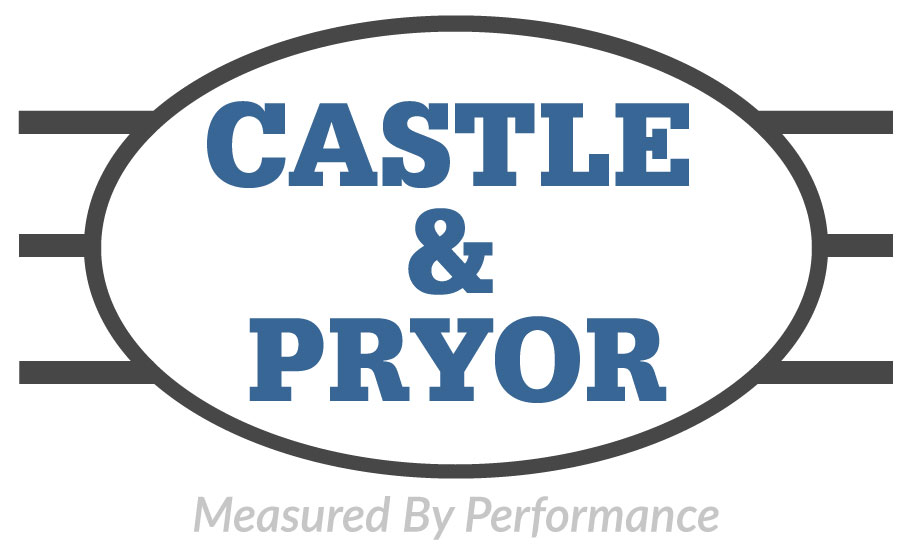Castle & Pryor Ltd
Airport Concrete Diamond Drilling and Saw Cutting - Maxicrete Concrete / Asphalt Repairs
Castle & Pryor are a diamond drilling and saw cutting company that our authorised signatories for HAL ( London Heathrow Ltd ) and GAL ( Gatwick Ltd ) who work both internally on Airport terminals and externally on the Airfield infrastructure. This (AS) status permits C&P to place dedicated employees and vehicles airside as and when required to carry out works directly for the Tier 1 contractors.
The service supplied involves diamond drilling and sawing concrete in order to facilitate services which are required to keep the Airport working to its full capacity.
These concrete drilling and sawing operations are varied and wide-ranging in as much it could be a single shift operation involving a few holes for mechanical engineers or long term external contracts working on the infrastructure that make up the aprons, taxi ways and runways.
These works comprise of but are not limited to, diamond drilling sockets and precision sighting of aircraft landing lights ( AGL’s) saw cutting and isolation of hard standings and structures for refurbishment, forming trenches and channels for pipelines and cables, sealing and cutting of joints for expansion and reinstatement of patch repair concrete and asphalt.
All of these works are often sensitive and time dependant so planning and site operations need to be thoroughly thought out and robust to ensure a satisfactory outcome.
In order to do this successfully you have to have the right calibre of staff and specialised equipment who are trained and suitable to accommodate Airport constraints and methodology. You have to view and assess each job independently so that all risks are nullified and methodology of works comply with good working practice.
With over 25 years of experience within the aviation/construction industry and ideally located at the home of aviation Farnborough Hants we are able to service both the main UK hubs LHR and LGW offering a 24hr – 7day week service to all our customers at very short notice.
All our field engineers are accredited to work airside and are trained to the NVQ level 2 standard in diamond drilling and saw cutting all directed and managed by SSSTS and SMSTS skilled supervisors and managers ensuring that our works are carried out to a high standard, safely and on time.
We are so confident and proud on being able to deliver this specialised service we termed our slogan measured by performance to underpin quality with guaranteed value, which is driven by a dedicated experienced team of loyal and enthused members of staff.
To help us to maintain safety, quality, and value we belong to various key associations CHAS, ( safety ) ISO9001 : 2015 ( quality ) and the DSA ( operations) which gives us the platform for our processes and procedures to ensure that we deliver on all our key values throughout the year.
To date we have secured new contracts for 2017 with all Tier 1 aviation / construction contractors both within the terminals and on the external infrastructure. We are proud to be part of the team that make up HAL and GALs infrastructure and look forward to continued success today and in the future.
Company Profile
-
Diamond Drilling
Diamond drilling is a non-percussive action that will cut non or reinforced concrete with minimal vibration and noise. It generally requires water to lubricate the diamond cutting segments as this acts as a cooling agent whilst works are in progress. The holes can be cut with extreme precision and can vary in size and depth depending on the clients requirements. All slurry generated from the works can be controlled and disposed of using vacuum rings and hoovers at source so that a controlled environment is maintained throughout the cutting process.
All holes can be formed vertically, horizontally or on the angle making the process very flexible to suit most challenging projects.
Diamond drilling is used widely throughout the aviation / construction industry and is recognised as a very practical and efficient way of forming holes in concrete with minimum disruption.
Practical typical uses for forming singular holes are, but not limited to, pipes and cables for mechanical engineers or civil contractors for bollards – barriers or Aircraft runway lights (AGL’s).
Should the requirement be for an opening then the holes can be linked together to form a continuous line, this is known as stitch drilling which is generally carried out using 107 / 127mm diameter cutting heads as they are the optimum size for commercial viability and speed when using this type of method.
Diamond drilling can be carried out using various diameters to a depth and location of your choice and generally consist of a man and a van to fulfil most on site requirements.
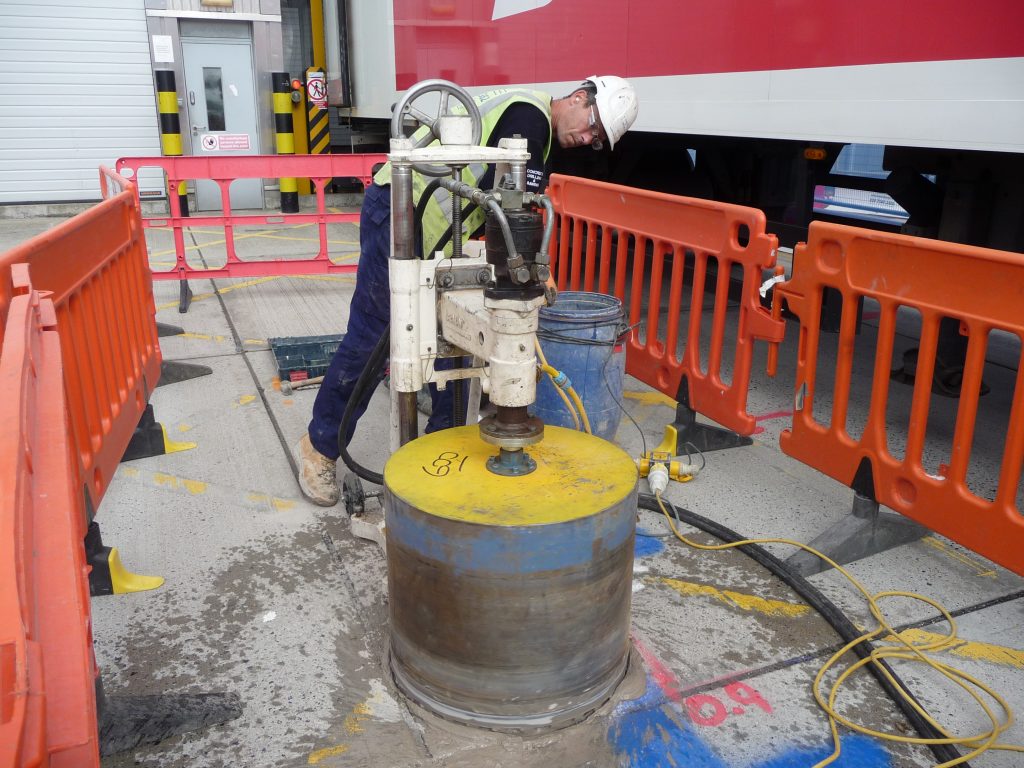
-
Concrete Floor Sawing
In the aviation /construction industry concrete floor sawing is mainly utilised to carry out two main functions.
- Form joints in the concrete to allow for expansion
- Separate or isolate a given area of structural concrete so that new or refurbished works can be undertaken.
The process of cutting concrete or asphalt on the ground is normally executed using a single diamond blade attached to a rotating shaft on a diesel or electrically powered floor saw. The floor saw is self-propelling and operated by a skilled operator from the controls at the back of the machine. Once the given area is clearly marked and all permits have been signed off the operator will begin to cut the material along its length in 25mm increments so that a true and even cut is established in line with good working practice.
Whilst the concrete floor sawing is in progress water is used to cool both the diamond segments upon the blade and to eliminate any air born dust generated from the cutting activity. Any slurry left as a consequence will be vacuumed up and disposed of in accordance with current SHE regulations.
Concrete floor sawing is a recognised practice at the Airport because it is quick, accurate and non-percussive so no vibration can be transferred through the concrete allowing full structural integrity to remain.
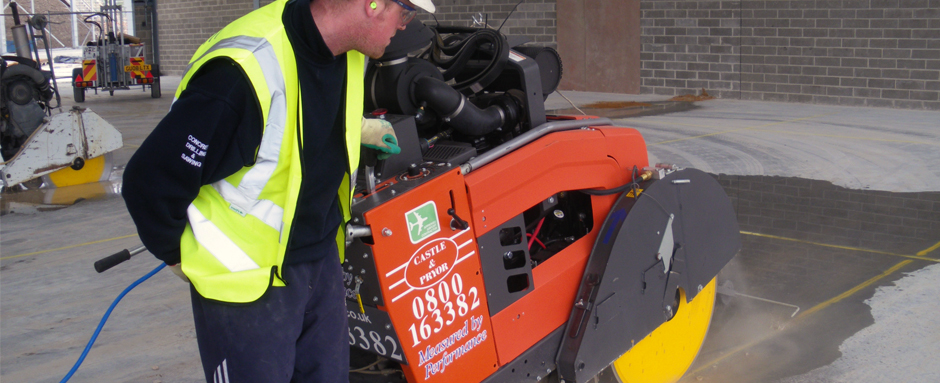
-
AGL Installation
AGL installation is an abbreviation for Airfield Ground Lightings.
These have to be changed periodically so that new installations can be fitted in accordance CAA regulations.
The AGL’s are formed into the concrete using a diamond drilling technique and can vary in size depending on whether they are for the taxiways, apron’s or runways.
The Lights are bedded into place using a resin powder mix, once seated they are scope sighted to the engineers specification and sealed with a pourable grout to ensure weather proofing and stability.
More than often all AGL’s installations will be carried out at night when the Airport is at its quietest and will be time and temperature dependant so planning and operations have to work like clockwork to ensure a satisfactory outcome.
Most AGL installations comprise of STOP Bar, Straight, and Radius configurations.
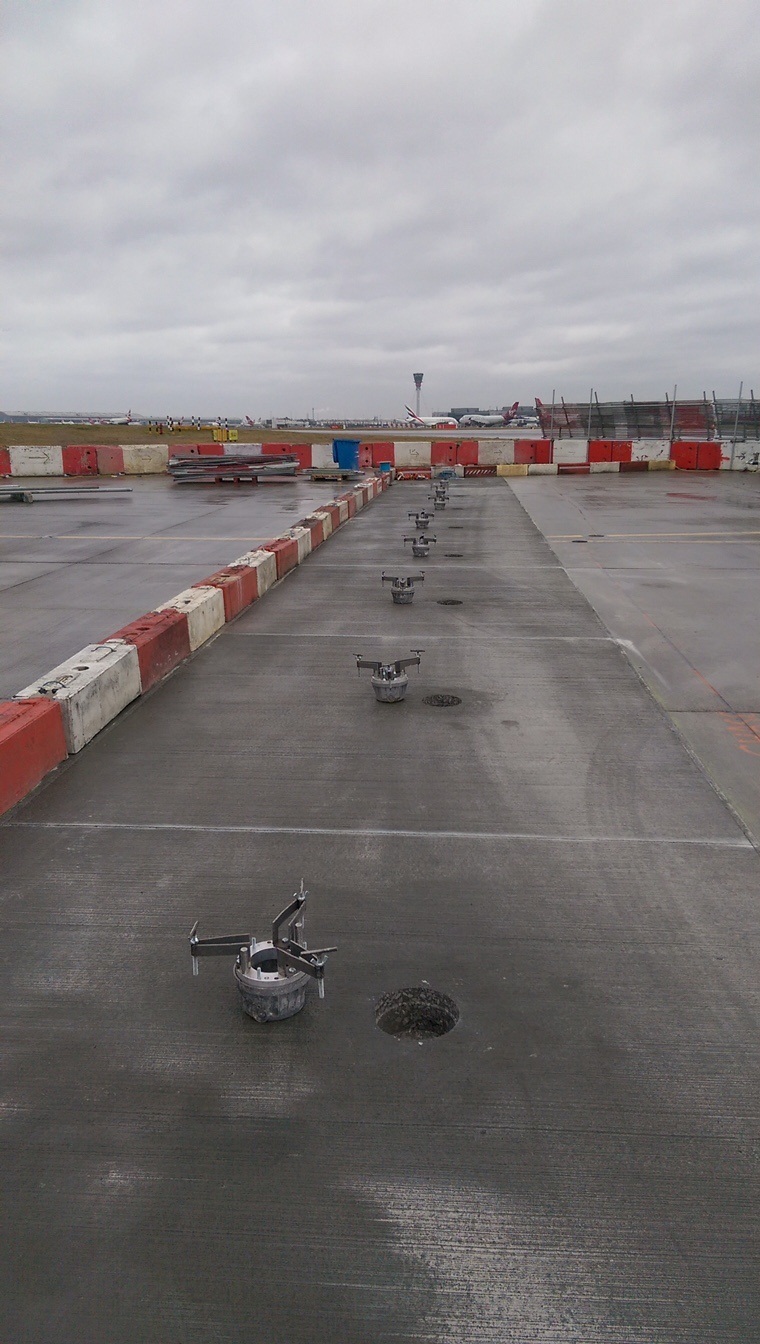
-
Wire Sawing
Concrete wire sawing is particular method used for cutting reinforced concrete or steel when conventional methods of sawing are either not viable or suitable for the task in hand. An example of this might be that the concrete to be removed is 6.0m in diameter and 150mm high and a flush cut is required to meet the clients specification. Only a wire saw could do this job competitively, quietly, and free of vibration making it an ideal solution for removal.
The process works by wrapping a diamond segmented wire around the material that needs to be cut. Once positioned by aid of the guide pullies the wire is then connected to the large drive pulley and motor and tensioned to the operators satisfaction. Once secure the wire is then pulled around the material in a circular motion so that a cutting action is generated via the diamond segments. The diamond wire will remain tensioned throughout the cutting process until it has completed the job. Any heat generated from the friction of cutting is water cooled on to the wire itself. Concrete wire sawing can be carried out vertically, horizontally flush or angled making it a very viable proposition when looking to remove large awkward concrete or steel structures.
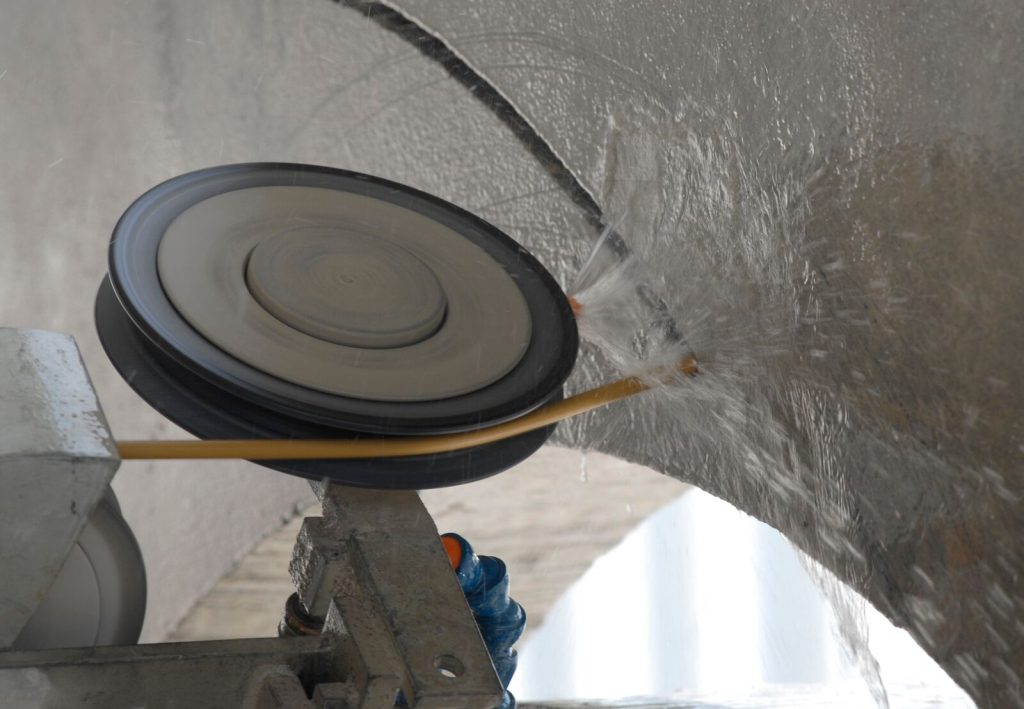
-
Track Sawing
Track sawing also known as wall sawing. The reason for this is because it does both, the saw head is attached to a track which keeps it secure and the track is bolted to a wall to ensure accuracy and stability during the cutting process.
Track sawing can be carried out vertically, horizontally, flush or angled to suit the particular task in hand. The depth of cut would be max 750mm depth using specialised equipment. Throughout the cutting process the blade would be lubricated with water to cool the cutting segments and polythene bunded if necessary to aid any water control requirements.
Track sawing comprises of three main components: – Saw head, Track, and High frequency power pack all of which can be broken down and reassembled where required. This makes this technique very flexible especially if work area has weight, access and ergonomic restrictions.
Track sawing is often associated with forming doorways and window opening as its versatility and ergonomics suit this type of operation.
Track sawing equipment can be fitted into a standard van and operated by one skilled operative, power requirements are 3 phase and utilised via the onsite grid system ideally located in close proximity to avoid excess cabling.
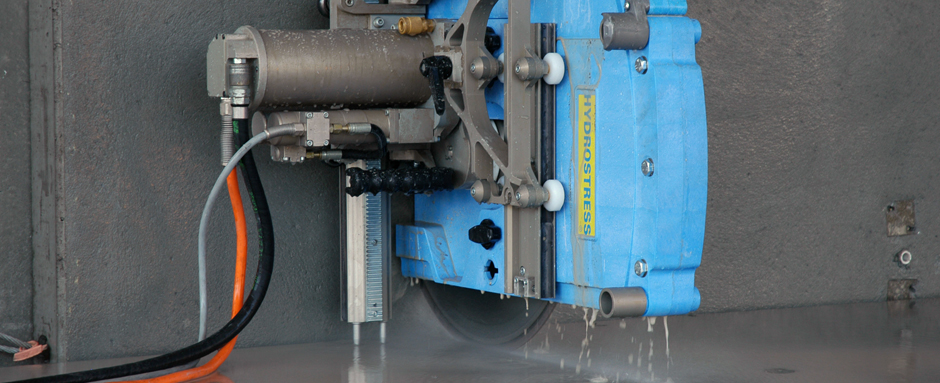
-
Concrete Grooving
Concrete grooving is a technique where multiple diamond cut grooves are cut into the surface of the concrete in order to keep the surface dry and to release surface tension. The grooves work in two ways firstly by allowing any surface water to run into the grooves and drain to a suitable outlet and secondly preventing the squeeze of water when two flat surfaces come together causing aquaplaning.
A common place to find concrete grooving is on a runway because the runway is generally flat in order to accommodate the ergonomics of a landing aircraft. Therefore to illuminate any surface water on the flat surface the grooves in the runway have to be formed with a fall beneath the surface so that the water can drain within the confines of the grove to the soft verge or suitable drain system situated at the runways edge.
The concrete grooves are formed using multi diamond bladed floor saw which cuts the parallel grooves across the surface of the runway at 25mm centres up to 5.0mm width. The operation is very quick and requires no curing time as know building materials are required throughout this grooving process.
Due to the restricted hours often associated with Airfield works the concrete grooving process meets that stringent requirement as it’s its quick to mobilise and demobilise and once complete it can be utilised straight away.
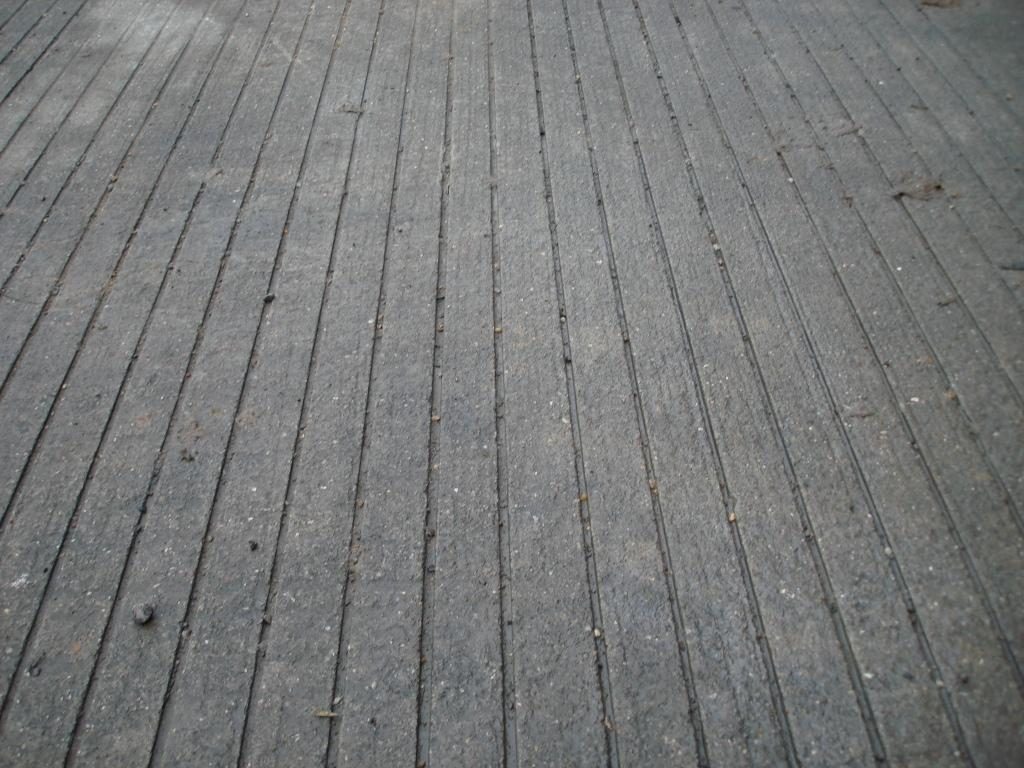
-
Dowel Bar Drilling
Dowel bar drilling is a term used when steel dowel rods are inserted into an existing concrete structure in order to facilitate a new concrete cast to be adjoined. The steel dowel rods are inserted into a pre-drilled hole which is slightly larger than the diameter of the rod, and drilled to a depth specified by a structural engineer.
The holes are formed using a percussive technique and are normally spaced at pre-determined centres along the adjoining length in order to create an symmetrical anchorage along the construction joint. The percussive technique adopted to drill the holes roughen the sides of the hole in order to give the resin anchorage a suitable surface to adhere to. Once placed and cured the dowel bars are then wrapped in a protective sheath in order to protect the integrity of the steel.
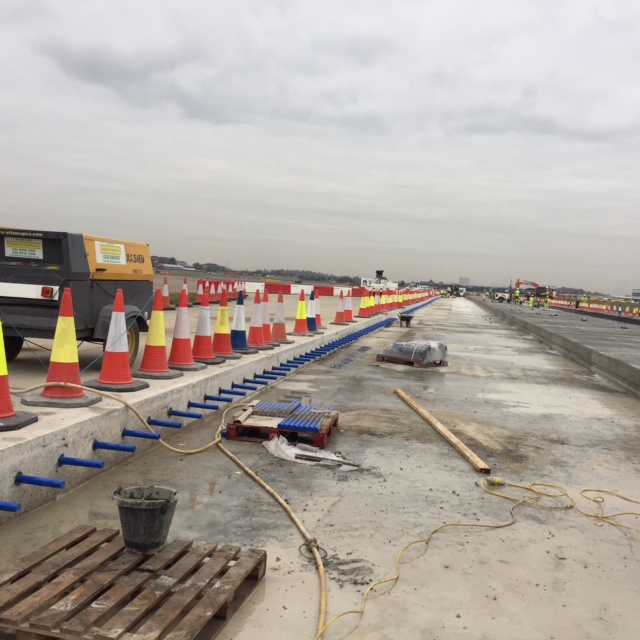
-
Floor Preparation
Concrete Floor Preparation has many facets, it can be but not limited to screed, paint, adhesive, vinyl or tile removal. Or it could be simply texturing for new coating or reducing the height of an existing level to another i.e. screed removal or sub-base planning. We have many different techniques to accommodate anyone of these challenges to ensure a satisfactory outcome.
If the concrete floor preparation is to be carried out internally then we would use electric machines and dust control vacuums so that a safe and clean environment is maintained throughout the floor preparation process.
In some cases multiple skills and machines are required to fulfil anyone task and works would be coordinated accordingly.
If the floor preparation is external then the only real difference might be the use of diesel machinery as fumes are acceptable in an open and well ventilated environment. Other factors on the other hand such as dust, slurry or disposal of waste has to be treated in accordance with SHE legislation.
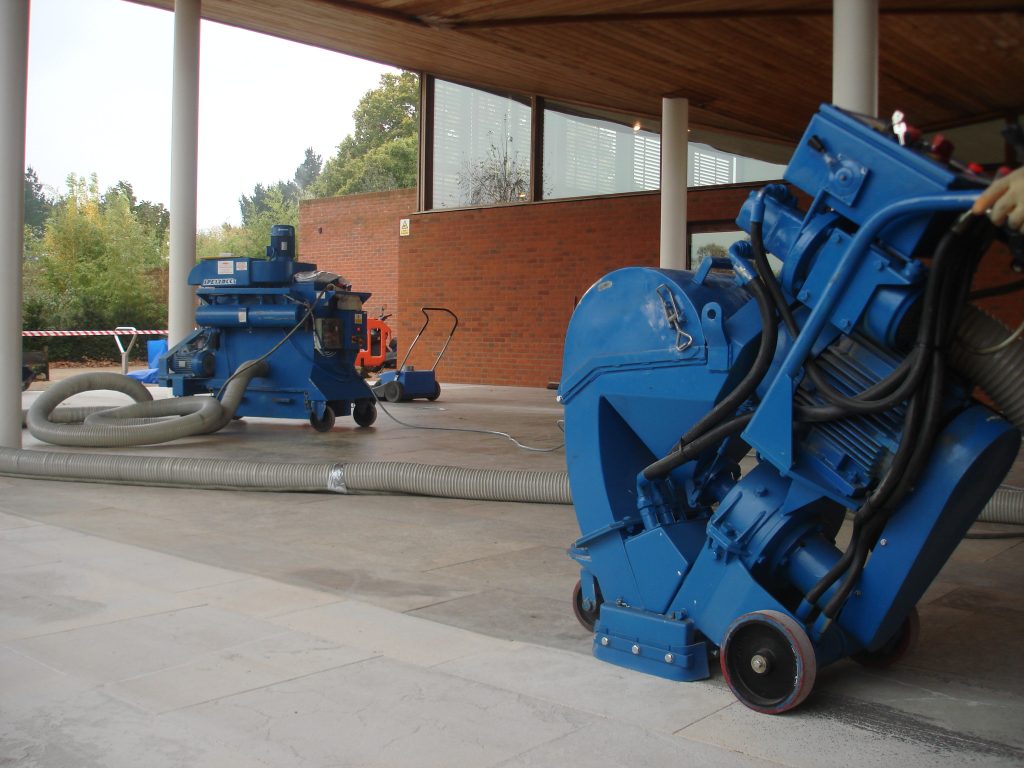
-
Grouting Chases
Grouting chases, this process seals the top proportion of anyone chase or slot from inclement weather and unwanted contaminates. The open chases are occupied with service utilities such as pipes and cables, this is then filled with a flexible based grout to facilitate any structural movement associated with changing external temperatures which will make the concrete expand or contract depending on whether it is hot or cold.
Once the utilities are stowed beneath the concrete surface away from Aircraft movement and amenity vehicles the top proportion of the slot will be sealed with a pourable grout so that a continuous seal is achieved throughout its linear length.
Like all Airfield works in procession this will be time dependant so it’s important to have the best methodology and application in place to maximise the production in anyone working window. At Castle & Pryor we have invested in the latest bespoke equipment and skilled operatives to achieve this goal insuring client confidence when working in often challenging environments.
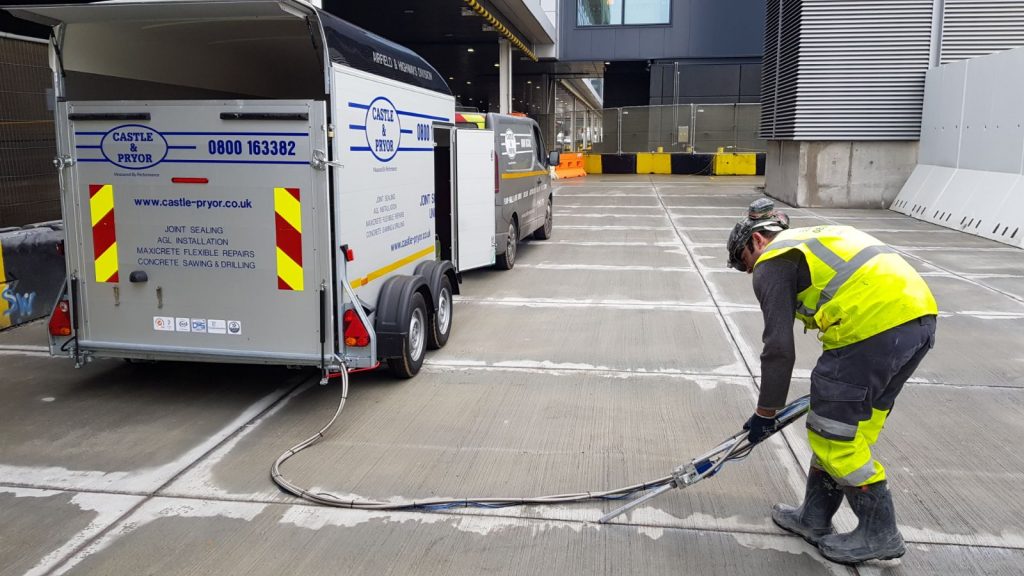
-
Maxicrete Concrete Patch Repair
Maxicrete concrete patch repair is undertaken on the external Airfield infrastructure under a maintenance programme and is regulated by the CAA (Civil Aviation Authority) and managed by the BAA (British Airport Authority)
Should cracks appear in the hard standing concrete or a joint edge then the integrity of the concrete and sharp edges have the potential to damage the wheels of moving aircraft and service vehicles on an everyday basis.
Once identified the damaged concrete repair maintenance programme will begin. The aforementioned area will be removed using a diamond cutting and breaking technique, once removed the remaining area will be checked for integrity, treated with a shot-blast texturing system and vacuumed ready to accommodate the new two part cementious Maxicrete concrete patch repair.
When carrying out the repairs only the top 40mm increment of the concrete is to be removed as the new Maxicrete concrete patch repair system has high strength properties and flexibility in order to cope with extreme weight loadings and movement generated by fluctuating temperatures.
Maxicrete concrete repair patches keep the Airfield infrastructure safe and moving, and are more likely to be installed at night in procession times when the Airport is closed to flights but open for maintenance. These essential works require the Maxicrete concrete repair material to cure to full strength within the time permitted within the procession, ready for when the first flight takes off.
Like all Airport maintenance there is one working window so it all has to be executed efficiently and within budget, so organisation, experience, and value are key fundamentals in delivering this outcome.
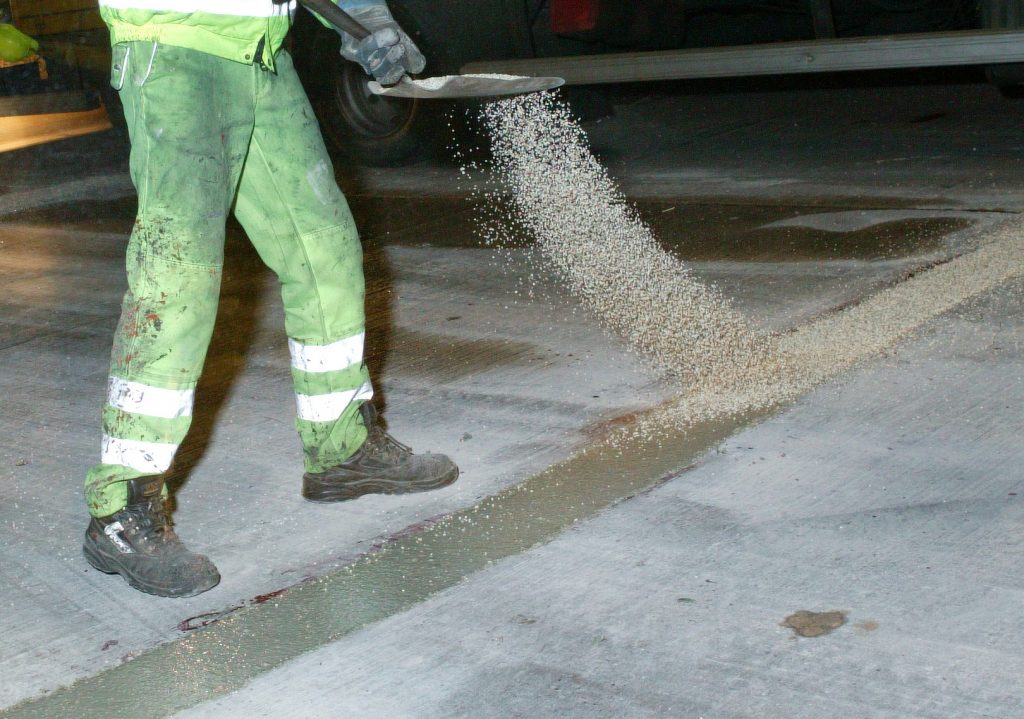
Images
Contact
Elles House
4B Invincible Road
Farnborough
Hants
United Kingdom
GU14 7QU
- 01252 524080
